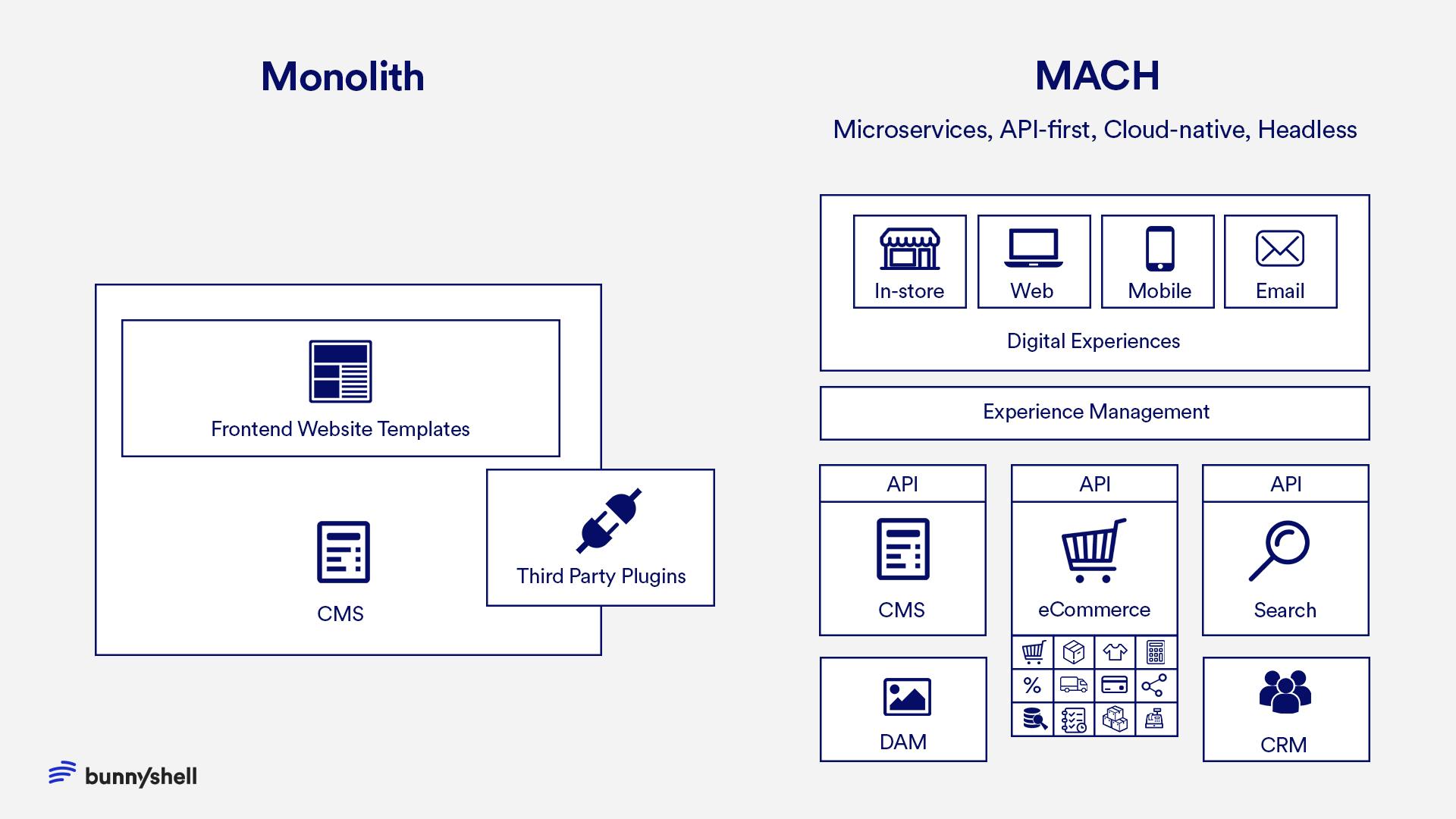Are you tired of relying on a single system or feeling locked into outdated tech? Business needs and customer expectations are constantly evolving, so you must find better ways to be customer-centric, agile, and future-proof to keep up with them. What better way to do that than by turning to the modern MACH architecture?
Find out what MACH architecture is, how it can increase the value of your business, and how you can use Environment as a Service (EaaS) to solve its complexities.
What Is MACH Architecture?
MACH architecture is a new, all-in-one tech platform, providing eCommerce businesses a way to deliver flawless customer shopping experiences across any device. The acronym MACH stands for:
- Microservices-based - independently managed, developed, and deployed stand-alone apps that replace the traditional, monolithic architecture
- API-first - the primary access point for a given feature. It connects all pieces of a system, making it possible for one or more apps or services to interact and operate together
- Cloud-native - software delivered through a SaaS model to host, store, scale, and automatically update functionality
- Headless - supports new business models by allowing a business to offer omnichannel customer journeys across multiple traditional and digital touchpoints. You have design freedom when creating the user interface (you can create custom frontend experiences, completely decoupled from backend) and can connect to other devices or channels (IoT, sensors, AR, existing apps).
These design principles work together to provide a scalable, agile, and flexible commerce solution.
MACH architecture lets you pick from the best tools on the market (making it easy to replace, add, and remove technologies in the future), and every one of its components is replaceable, scalable, and can be continuously improved. That means you no longer have to rely on a single system to handle everything or settle for ineffective components.

What Is the Business Value of MACH Architecture?
As more business tools become obsolete (sometimes as soon as they’re introduced), MACH architecture will help you stay ahead of the curve following tech changes. MACH architecture essentially allows you to break the re-platforming cycle by becoming the last re-platforming project you’ll need to complete. Some of the more notable ways in which MACH architecture adds business value include:
- Independence - you can take advantage of the best tech on the market and create a best-of-breed approach for your business to compose your custom solution instead of being limited. Additionally, since each microservice is independent, you can replace any of them with a home-grown or third-party service. More on this in a bit.
- Flexibility - choose the frontend tech or framework that suits your needs to solve a particular business problem
- Adaptability - it’s important to be able to rapidly make changes and innovate according to customer needs. MACH makes it possible for you to launch a rebrand for a client or add curbside pickup capabilities
- Cost-efficiency - since you’re able to scale microservices individually, you can optimize infrastructure costs and total cost of ownership year after year
- Higher development speed - you can usually save precious dev time since you’re capable of easily making rapid changes to your infrastructure as needed.
Now, let’s see how each design principle plays a role in adding value.
Microservices
Microservices are easy to scale because they use lightweight, flexible APIs to independently scale, update, and develop platform services in real-time based on traffic and individual service demands. These flexible APIs allow you to quickly create and test iterations of business requirements within the market. This also keeps your tech stack flexible, giving you the possibility to react to market changes proactively.
There’s minimal risk and impact involved in your overall implementation because your large block of components is broken down into smaller individual pieces that can work more effectively in isolation. Individual components mean you no longer have to over-provision your server capacity to adapt to demand, allowing you to optimize your infrastructure costs.
Additionally, you have seamless upgrades because you don’t need to package upgrades, updates, new functions, or patches into more significant releases. Not only that but your upgrades and release cycles are faster, enabling high uptime, where new features or bug fixes won’t affect other areas of the system (if one area goes down, the other services aren’t affected).
Pro tip: to ensure responsiveness and flexibility in an ever-changing eCommerce market, you can create the best solutions for your business by developing or replacing any microservice with a home-grown or third-party service.
API-first & Headless
By being API-first, you’re making your APIs the bedrock of your product offering, enabling functionality and complete coverage of all features. You can select any framework or frontend tech while ensuring you implement any required features.
A consistent, well-designed API will mask some of the complexities hidden behind an API layer and lessen devs’ learning curve. This means that with the ability to implement any framework or frontend tech and a reduced learning curve, you can deploy new solutions faster, resulting in accelerated time-to-market.
The combination of API-first and headless allows you to adapt and iterate according to your customer’s needs. Being headless will enable you to connect with your customers at any point in their journey through multiple frontend experiences (heads). Furthermore, separating frontend views from backend business logic drives revenue growth and can launch new business models.
By leveraging modern frontend tools, frameworks, and languages that match your business requirements, you can dramatically reduce page load times, in turn improving SEO, conversion rates, and organic reach.
Cloud-Native
There are many benefits to having your commerce service delivered via the SaaS model. Cloud-native software takes care of scaling and hosting the underlying infrastructure, taking the complexity away of managing it yourself. It can also be fully consumed via APIs, bringing multi-tenant features.
You don’t need to deploy or redeploy solutions as you can use the service as a whole or choose any of its separate components. SaaS solutions are also rapidly deployed, and you can auto-scale as needed according to your traffic demands and long-term business goals. Additionally, you’re reducing overhead as new feature releases are handled on your behalf.
MACH & EaaS - How You Can Solve Complexities
MACH architecture offers many advantages in terms of flexibility, adaptability, revenue growth, and development speed. You can respond quickly to changing customer demands while adapting to a dynamic market speed.
However, moving away from monoliths to more flexible models requires a change in processes within your business and a deep understanding of dependencies on a human, technical, and process level. That’s because restructuring within certain companies can pose many challenges, such as:
- Complexity and confusion around understanding how different services influence and interact with one another
- Understanding of potential costs, especially if you choose a multi-vendor strategy, and awareness of the system structure final expansion stage (legal and procurement details, purchasing conditions, etc. must be discussed with multiple vendors)
- Aligning people, technology, and processes to see which capabilities belong together
- These 8 uptime challenges can occur.
All of these issues make it crucial to have the right partners by your side when migrating to a modern tech stack.
With Bunnyshell’s Environment as a Service (EaaS), you can facilitate the move from monolithic apps with zero DevOps experience required for teams to build, deploy, and manage modern apps, further enabling:
- Better velocity
- Fewer bottlenecks
- Full remote work capabilities
- Complete flexibility over future changes to your app
- Faster results.
See more benefits of EaaS here.
You Can Either MACH It or Break It
MACH architecture solutions offer different sets of benefits and add business value. Not all solutions are the same, as some will fit a particular set of needs better than others.
Nevertheless, Bunnyshell fully embraces the principles of MACH architecture. Find out how Bunnyshell’s EaaS can help you become more agile and proactive in your digital strategy and how your business can benefit from MACH architecture, giving you an edge over your competition.
Enable High Velocity Development
Breakaway from the inability to quickly deploy isolated environments of any specification.
